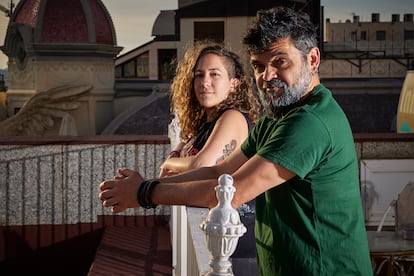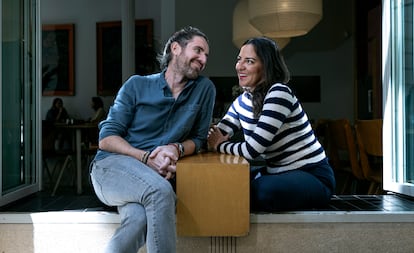Couples who chose to live apart: ‘In love, but not a slave’
For women who decide not to share a home with their partners, traditional perceptions of love give way to a newfound autonomy
“Okay, but you in your house and me in mine. I’m not going to be picking up anyone else’s underwear at 70 years old.”
That’s how Carmen answered Hilario five years ago. Hilario had asked her for a “normal” relationship, after a year of seeing each other almost every weekend and occasionally during the week. Carmen is not Carmen’s real name, and she assigned the name Hilario to her partner. She opts to withhold other personal details because she faced pushback for “having a boyfriend again” after being widowed. It wasn’t easy to explain why she refused to repeat the last 40 years. “But I share this because I didn’t think I would ever say that, when my husband died, and I spent a few years alone, I realized that I had been a slave my whole life. A lot of love, always, but a slave. And look how well I’m doing now, with each one of us in their own house. In love, but not a slave.”
It takes Carmen about 10 minutes to reach Hilario’s home from her own. They had that conversation one day while making the journey, and he never asked again. That talk never happened between Ana Llopis and Juan Carlos Gómez — their real names — who live in Granada. The 35-year-old translator and 46-year-old astrophysics researcher have been together since September 2020, and they have never lived together. They don’t want to. They live a little further from each other than Carmen and Hilario, about 40 minute apart. And their reasons are different but linked.

Llopis talks about “seeing relationships differently,” about “less dependence, more freedom and more equality.” Carmen mentions “unlearning what it means to be with someone” and “personal space.” In the stories of dozens of people interviewed, certain topics repeat themselves: deconstructing the traditional model of coupledom, the need for personal space, the economics of living separately, and the awareness that it is less eco-friendly. But, above all, they mention feminism. Women tend to be the ones to propose such arrangements. They cite their desires for autonomy and independence, as well the uneven share of domestic work that heterosexual partnerships usually imply.
‘Living apart together’ in the seventies
Partners have loved each other without cohabitating for years. In the late seventies, the concept became popular in the United States. The term “living apart together” —known by its acronym LAT— was coined. Since then, the phenomenon has grown, and it has accelerated in recent years. In the US, it was clearly reflected after the pandemic. Between 2000 and 2019, the number of married people who lived in two separate homes increased by 25%. In 2021, it reached 3.89 million people, approximately 2.9% of married Americans, according to Census data.
A 2018 poll in Spain found that 7.2% of the country’s population lived in such arrangements. 11.4% of them did so for work or education-related reasons, 3.7% for motives related to children or parents. 11.8% did so to “maintain their independence.”
Sometimes the reasons overlap. 50-year-old sociologist Esther Gil and 42-year-old art historian Nadia Cervera have been in a relationship for three years, after Gil went through a “friendly divorce.” Gil has two children, and Cervera takes care of her mother. They share “spaces of entertainment and relaxation,” and each of them is responsible for their own families.
‘Living together is an option, not the end of the road’
There’s no single profile of these couples. They come from a wide range of circumstances, but there are some similarities. A study by the BBVA Foundation, published last year, indicates some of them: the average age is 42.3 years old, one out of three comes from a separation or divorce and 46.5% have a college-level education.

Vicen Ybarra and Xisco Zafra fit into those percentages. They met on Tinder almost three years ago. She is 44 and works in healthcare, and he is 45 and a teacher. “We have had several previous relationships, with and without living together, each one with a marriage of more than 10 years. Both of us have two children from those marriages, and we don’t have the slightest intention of moving in together. In fact, it’s been a sine qua non requirement, mainly on my part, to keep moving forward. I emphasize that to my son and daughter: living together is an option, not the end of the road.”
These relationships are linked to social changes in recent decades, especially among young people, as the BBVA Foundation points out. But they aren’t free from critiques. Especially as they grow older, there “is a critical discourse about the fact of not wanting to live together as a personal option, as it affects the classic romantic concept of a couple.” Those who take this stance “interpret not living together as a lack of commitment, as a symbol of selfishness that directly conflicts with the fact of sharing that the couple represents.”
Almudena Hernando, an archaeologist and lecturer at Madrid Complutense University, who researches the archaeology of gender and construction of identities, draws attention to the word “selfishness.” “It’s said that people now aren’t generous, that they don’t know how to live together, that they don’t live together because they can’t handle anything, because they don’t love each other, because love is generous and noble. But the ones who gave, who were generous, were, and are, the women.”
A change thanks to feminism
That change, “clearly related to feminism,” says Hernando, is a demonstration “of each person’s ability to sustain themselves” in a society in which women are leaving behind “the traditional domestic role of caretaker and emotional support.”
Writer Coral Herrera, an expert on feminism and romantic love, explains that cohabitation usually leads to women playing the role historically assigned to them. Choosing an alternative goes against the deeply ingrained myths “of the selfless woman, the woman who is the support system and endures everything. It breaks the model of femininity and care, and it centers the importance of self-care and avoiding abusive relationships. It also breaks with the myth of the single, true and eternal love, as it doesn’t fulfill the traditional structure, and it also breaks with the fear of solitude, the fear of being alone, of growing old alone,”
She is convinced that living apart is better for women, unless “you find a partner who is really committed to change, and it’s difficult to find.” That partner could be Antonio. The 55-year-old, who lives in Barcelona, has been with 46-year-old Pilar for a decade. For him, living apart is an “evolution” of relationships.
He notes that the structure is viable under certain conditions: a mature relationship, both parties have a life beyond the other person, a fulfilling professional career that gives them economic independence. “We’re two individuals, not a limited pair. There should be conditions of equality, an independent woman and an independent man. The other one isn’t there to fill a void, but to share.”
‘Men need to learn how to relate and to care’
In her book Reinventar el amor, Mona Chollet refers to Eva Illuz’s book El fin del amor. Illouz discusses the growing inability to establish lasting relationships, citing signs such as the increase in family units composed of one person.
But for Chollet, it is “a mistake” to conflate cohabitation and commitment. “Naturally, you can love and care for the person who you live with. You can live alone and be a psychopath who is as cold as an iceberg. But you can also live alone and be passionately committed to someone. And you can live with a partner out of comfort, laziness, conformity or because you don’t have the means to move. Being captive is the same as not being committed.”
Half a century ago, that captivity was one of the few possible ways of life for women. But it’s less and less necessary. “We can sustain ourselves professionally, economically, and in a relationship. We know how to do it. Men need to learn how to relate, to sustain themselves, to care. As most of them have not done that, women find a mismatch. There are few men that know how to do both,” Almudena Hernando explains.
That is the basis of what Carmen told Hilario five years ago: “Okay, but you in your house and me in mine. I’m not going to be picking up anyone else’s underwear at 70 years old.”
Sign up for our weekly newsletter to get more English-language news coverage from EL PAÍS USA Edition
Tu suscripción se está usando en otro dispositivo
¿Quieres añadir otro usuario a tu suscripción?
Si continúas leyendo en este dispositivo, no se podrá leer en el otro.
FlechaTu suscripción se está usando en otro dispositivo y solo puedes acceder a EL PAÍS desde un dispositivo a la vez.
Si quieres compartir tu cuenta, cambia tu suscripción a la modalidad Premium, así podrás añadir otro usuario. Cada uno accederá con su propia cuenta de email, lo que os permitirá personalizar vuestra experiencia en EL PAÍS.
¿Tienes una suscripción de empresa? Accede aquí para contratar más cuentas.
En el caso de no saber quién está usando tu cuenta, te recomendamos cambiar tu contraseña aquí.
Si decides continuar compartiendo tu cuenta, este mensaje se mostrará en tu dispositivo y en el de la otra persona que está usando tu cuenta de forma indefinida, afectando a tu experiencia de lectura. Puedes consultar aquí los términos y condiciones de la suscripción digital.
More information

How to date in the Tinder era when you’re over 40
Últimas noticias
Most viewed
- Reinhard Genzel, Nobel laureate in physics: ‘One-minute videos will never give you the truth’
- Oona Chaplin: ‘I told James Cameron that I was living in a treehouse and starting a permaculture project with a friend’
- Pablo Escobar’s hippos: A serious environmental problem, 40 years on
- Why we lost the habit of sleeping in two segments and how that changed our sense of time
- Chevy Chase, the beloved comedian who was a monster off camera: ‘Not everyone hated him, just the people who’ve worked with him’










































